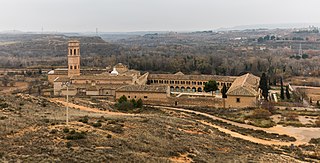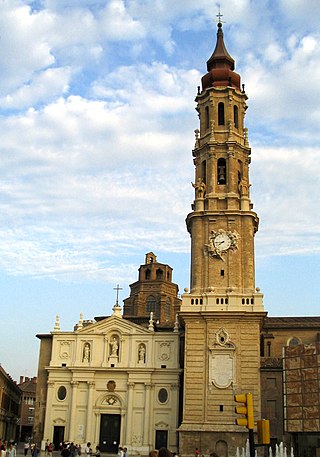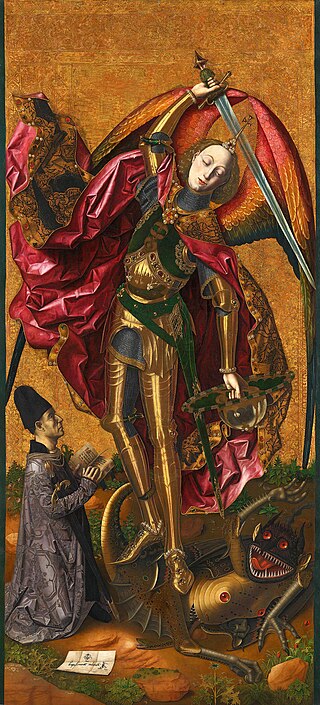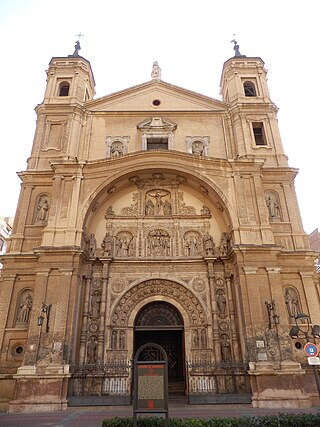
Poblet Abbey, otherwise the Royal Abbey of Santa Maria de Poblet, is a Cistercian monastery, founded in 1151, located at the foot of the Prades Mountains, in the comarca of Conca de Barberà, in Catalonia (Spain). It was founded by Cistercian monks from France. The main architect was Arnau Bargués.

The Cathedral of the Savior or La Seo de Zaragoza is a Catholic cathedral in Zaragoza, in Aragon, Spain. It is part of the World Heritage Site Mudéjar Architecture of Aragon.

The Monastery of Santa Maria de Santes Creus, is a former Cistercian monastery in the municipality of Aiguamúrcia, Catalonia, Spain. The abbey was erected in the 12th century, in today's municipality of Aiguamúrcia, in the village of Santes Creus, in the province of Tarragona (Catalonia). However, it was in the thirteenth century when Peter III of Aragon expressed his desire to be buried in the monastery and a royal crypt was built for himself and his son, King James II that many of the local nobility established the custom to choose this place for burial. This led the monastery to increase in splendor and greatness thanks to the numerous donations received.

The 1808 siege of Zaragoza was a bloody struggle in the Peninsular War. A French army under General Lefebvre-Desnouettes and subsequently commanded by General Jean-Antoine Verdier besieged, repeatedly stormed, and was repulsed from the Spanish city of Zaragoza in the summer of 1808.

Rueda Abbey or Rueda de Ebro Abbey is a former Cistercian monastery in Sástago in the Ribera Baja del Ebro comarca, province of Zaragoza, Aragon, Spain, 74 kilometres to the south-east of Zaragoza on the left bank of the Ebro. The buildings have been preserved by the government and are intended to be used for a hotel and conference centre.

The Archdiocese of Saragossa is a Latin diocese of the Catholic Church located in north-eastern Spain, in the province of Zaragoza, part of the autonomous community of Aragón. The archdiocese heads the ecclesiastical province of Saragossa, having metropolitan authority over the suffragan dioceses of Barbastro-Monzón, Huesca, Tarazona, and Teruel and Albarracín.

The Isabelline style, also called the Isabelline Gothic, or Castilian late Gothic, was the dominant architectural style of the Crown of Castile during the reign of the Catholic Monarchs, Queen Isabella I of Castile and King Ferdinand II of Aragon in the late-15th century to early-16th century. The Frenchman Émile Bertaux named the style after Queen Isabella.

Bartolomé Bermejo was a Spanish painter who adopted Flemish painting techniques and conventions. Born in Cordoba, he is known for his work in the Crown of Aragon, including the Principality of Catalonia and the Kingdom of Valencia. His real name was Bartolomé de Cárdenas: the name Bermejo, which means auburn in Spanish, possibly relates to his hair colour. Bermejo may relate also to his surname, Cárdenas; Cardeno means purplish. He signs himself sometimes as "Bartolomeus Rubeus" meaning possibly "Bartholomew the Redhead".

Engratia is venerated as a virgin martyr and saint. Tradition states that she was martyred with eighteen companions in 303 AD.

The Church of Santa Engracia de Zaragoza is a basilica church in Zaragoza, Spain. It was built on the spot where Saint Engratia and her companions were said to have been martyred in 303 AD. The Basilica of Santa Engracia is located at Plaza de Santa Engracia.

The Cathedral of Our Lady of the Assumption and of Saint Fructus is a Roman Catholic cathedral located in the Spanish city of Segovia. The church is dedicated to the Assumption of the Virgin Mary and to Saint Fructus and is the seat of the Diocese of Segovia. It was built in the Flamboyant style, and was dedicated in 1768, constituting one of the latest Gothic cathedrals in Europe.

Damià Forment was an Aragonese Spanish architect and sculptor, considered the most important Spanish sculptor of the 16th century.
Engracia or Engrácia may refer to:

The Royal Monastery of St. Jerome is a Roman Catholic Hieronymite monastery in Granada, Spain. Architecturally, it is in the Renaissance style. The church, famous for its architecture, was the first in the world consecrated to the Immaculate Conception of Mary.

The Monastery of Sant Jeroni de Cotalba is a monastic building of Valencian Gothic, Mudéjar, Renaissance, Baroque and Neoclassical styles constructed between the 14th and 18th centuries, located in the municipal area of Alfauir, (Valencia), Spain, about 8 km. from the well-known city of Gandia.

The Monastery of Santa María de Huerta is a Cistercian monastery located in Santa María de Huerta, a town of the Spanish Province of Soria, within the autonomous community of Castile and León. The first stone of the building was laid by Alfonso VII of León and Castile in 1179.

The Monastery of Santa Maria de la Murta is a former monastery of the order of the Hieronymites located in the Valley of La Murta in Alzira (Valencia), Spain.
The following is a timeline of the history of the city of Zaragoza, Spain.
Joan Perez Garcia de Olivan born as Joan Pérez García de Oliván held the titles of Bishop of Urgell and co-prince of Andorra





















